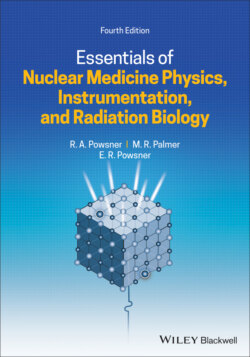Читать книгу Essentials of Nuclear Medicine Physics, Instrumentation, and Radiation Biology - Rachel A. Powsner - Страница 38
Half‐life
ОглавлениеIt is not possible to predict when an individual nuclide atom will decay, just as in preparing popcorn one cannot determine when any particular kernel of corn will open. However, the average behavior of a large number of the popcorn kernels is predictable. From experience with microwave popcorn, one knows that half of the kernels will pop within 2 minutes and most of the bag will be done in 4 minutes. In a like manner, the average behavior of a radioactive sample containing billions of atoms is predictable. The time it takes for half of these atoms to decay is called (appropriately enough) the half‐life, or in scientific notation T1/2 pronounced “T one‐half”). It is not surprising that the time it takes for half of the remaining atoms to decay is also T1/2. This process continues until the number of nuclide atoms eventually comes so close to zero that we can consider the process complete. A plot of A(t), the activity remaining, is shown in Figure 1.23.
Figure 1.21 Decay schematics.
This curve, and therefore the average behavior of the sample of radioactivity, can be described by the decay equation:
where A(0) is the initial number of radioactive atoms.
A commonly used alternative form of the decay equation employs the decay constant (λ), which is approximately 0.693 divided by the half‐life (T1/2):
The decay equation can be rewritten as
The amount of activity of any radionuclide may be expressed as the number of decays per unit time. Common units for measuring radioactivity are the curie (after Marie Curie) or the SI unit, the becquerel (after another nuclear pioneer, Henri Becquerel). One becquerel is defined as one radioactive decay per second. Nuclear medicine doses are generally a million times greater and are more easily expressed in megabecquerels (MBq). One curie (Ci) is defined as 3.7 × 1010 decays per second (this was picked because it is approximately equal to the radioactivity emitted by 1 g of radium in equilibrium with its daughter nuclides). A partial list of conversion values is provided in Table 1.2.
A related term that is frequently confused with decay is the count, which refers to the registration of a single decay by a detector such as a Geiger counter. Most of the detectors used in nuclear medicine detect only a fraction of the decays, principally because the radiation from many of the decays is directed away from the detector. Count rate refers to the number of decays actually counted in a given time, usually counts per minute. All things being equal, the count rate will be proportional to the decay rate, and it is a commonly used, if inexact, measure of radioactivity.
Figure 1.22 Decay schemes showing principal transitions for technetium‐99m, indium‐111, iodine‐131 and radium‐226. Energy levels are rounded to three significant figures.
Figure 1.23 Decay curve. Note the progressive replacement of radioactive atoms (parent) by relatively more stable atoms (daughter) as shown schematically in each box.
Table 1.2 Conversion values for units of radioactivity
| One curie (Ci) = | 1 × 103 mCi | 1 × 106 μCi | 37 × 109 Bq | 37 × 103 MBq | |
|---|---|---|---|---|---|
| One millicurie (mCi) = | 1 × 10–3 Ci | 1 × 103 μCi | 37 × 106 Bq | 37 MBq | |
| One microcurie (μCi) = | 1 × 10–6 Ci | 1 × 10–3 mCi | 37 × 103 Bq | 37 × 10–3 MBq | |
| One bequerel (Bq)* = | 27 × 10–12 Ci | 27 × 10–9 mCi | 27 × 10–6 μCi | 1 × 10–6 MBq | |
| One megabequerel (MBq) = | 27 × 10–6 Ci | 27 × 10–3 mCi | 27 μCi | 1 × 106 Bq |
* One bequerel = 1 decay per second.
